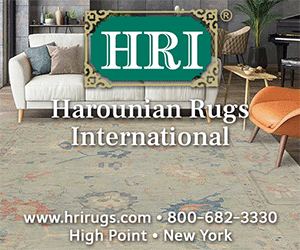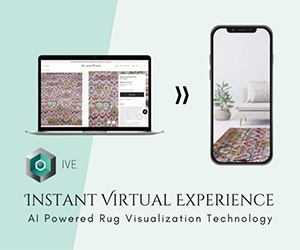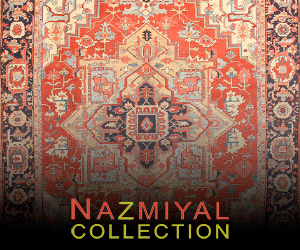A continued exploration of a new approach to rug making.
Purchasing a hand-knotted rug or carpet by first determining size, budget, and texture before even considering design or color seems antithetical to traditional rug sales models. In many ways it is. Yet, these same criteria have long been used to steer clients toward in-stock rug purchases. Ali Ghassemi considers these timeless questions as he embarks on redefining the craft of rug making for the modern consumer.
“So, where were we?” asks Ali Ghassemi of Toronto, Ontario’s Weaver and Loom. “We were role-playing a purchasing scenario in which I need a new rug for my fictitious television room off the master bedroom,” I reply. “Right!” says Ghassemi. “So, now that we’ve determined the size you need, 8’5” x 9’0” (2.57m x 2.74m), your budget, $5500 USD, and the function of the space, casual and low traffic, we proceed to show plain, off-white hand-knotted samples of the various options available—up to and including your budget of $72.60 per square foot.” “Yup, I’m with you so far, but what about design?” I inquire. “Don’t get ahead of the process,” retorts Ghassemi.
The process behind Ghassemi’s sales approach is elegant in its simplicity of message. By analyzing the various parameters specified by the client, Ghassemi seeks to ensure maximum customer satisfaction, minimize frustration and disappointment, and cater to the made-to-order demands of today’s hand-knotted rug market. Unlike “tried and true” sales models of the past built upon either dealer in-stock goods or readily available programmed wares from importers and wholesalers, or most recently customization of existing designs, Ghassemi’s model acknowledges the commodity-driven nature of the early 21st century hand-knotted rug market.
“Listen Michael,” begins Ghassemi “This process is not for those consumers seeking an art rug. This is a more commercialized approach.” By foregoing both the more niche art rug market as well as the marketing hype of brand-heavy firms, and focusing instead on genuinely matching consumer needs and wants with products well suited to the task, Ghassemi is fostering a new generation of educated consumers.
In the scenario under consideration, multiple material and construction options are available. For example, an Indian-made 9/25 loop-and-cut and a 10/34 loop-and-cut in 100% Merino wool are options, as are a Nepali-made Tibetan weave in 40 knot or 60 knot in 100% Tibetan wool. All four offerings are within the budget range and include the option to add a touch of viscose, up to 15%, at no additional cost. Genuine silk is not an option within this budget. “You could also have a 6/6 or an 8/8 Pakistani rug made of Ghazni wool and then there are many flatweave options as well,” concludes Ghassemi.
My affinity for Nepali-made carpets predicates that I select the 60 knot Nepali-Tibetan. In actuality, the few technical differences—aside from material—between it and the 10/34 loop-and-cut from India truly leaves the decision to one of personal preference or attraction. The focus on technical details is intentional and harkens back to earlier rug sales models that have broadly given way in the face of commercialization and mechanized production of rugs and carpets, save for the collectors’ market wherein make and model are ever important. For the rug buyer—novice, casual, or otherwise —this information can suddenly seem overwhelming; this is tempered by Ghassemi’s salesmanship and the samples of the actual qualities at hand.
Less of a case of “baffle them with bull,” and more of provide the client with all the information so that they may make an informed decision, Ghassemi’s approach favors allowing the client to decide what is or isn’t important to them in this process. Clients often ask about the difference between qualities, knot density grading systems, materials, and so forth, and Ghassemi is happy to oblige with answers explaining it all. At the end of this part of the consultation, before design is even considered, a client knows the cost, size, and texture of the finished carpet. The design—whatever it may come to be—will be tailored to the specifics of the selected quality, which matches the parameters of the client.
“Sometimes during the process the client decides to reevaluate their parameters,” begins Ghassemi. “This isn’t because I am pressuring them to upgrade to silk, or mohair, or anything like that. But by providing straight-forward information I find clients are eager to engage, and touch samples, and explore the options available to them. Even if this means changing one of their parameters.” To achieve the goal of ultimate satisfaction, this part is crucial. A client who feels as though they have personally exhausted all the options to arrive at the best one for them is also a satisfied client. “So, we’ve now shown you all the options, given you the details, and you—as the client—can now take this information and decide what to do next,” states Ghassemi.
“Can we talk about design yet?” I ask Ghassemi, “Or is there something else to consider?” At this point the considerations are multifaceted and relate not just to what the customer will do next, but also what Weaver and Loom will, or more accurately, won’t do. “If the customer doesn’t contact us again about the rug, we won’t contact the client,” says Ghassemi.
What would happen if a client were to take the provided information into a competitor to try and “shop” the rug? In short, we agree a prospective client asking to see the available options in a specific quality, such as the aforementioned 60 knot Nepali-Tibetan, is likely to be met with a combination of confounded looks from salespeople and a near-endless array of design offerings that may, or may not, meet the desires of the client. Moreover, it seems unlikely they would be met with a comparable blank slate approach to rug making. “Many [salespeople] don’t know what to do or how to respond to these types of questions,” states Ghassemi. Surely some rug dealers who favor more traditional sales models may object to this approach. But if, in the end, the industry truly desires educated consumers, it must be prepared to deal with said educated consumers.
“So, the client says ‘Yes! I want to proceed,’ what happens next?” I ask. “Now we discuss design,” says Ghassemi, and the bespoke element of his system comes into sharp focus.
While not freed from the parameters which constrain the project, Weaver and Loom is now, however, licensed to operate within them, knowing any design they create specifically for the client must meet these criteria. Much like the questions asked of the client (size, budget, texture) are the same and traditional, so is the approach of designing a rug to a specific quality and texture. “If you had chosen the 8/8 Pakistani made of Ghazni wool, we would create a design knowing the variation in color (abrash) might be as high as 25%,” says Ghassemi who further adds, “And we would have made the client aware of this high-degree of color variation during the selection process.” This is just one example, and it illustrates how a predetermined quality—the sum of all the constituent technical details: country of origin, material, density, et alia as opposed to measure of craftsmanship—can guide, and foster, the design process.
“At this point we would ask the client to provide anything they feel may help the design process,” says Ghassemi. This includes fabric samples, inspirational photographs, props, decorative accessories or tchotchkes—even photographs of rugs the client likes. This information is then passed to Weaver and Loom’s design department which is tasked with creating two to three working designs from which the client will then winnow a finalist. Finishing options related to the predetermined criteria are also considered, as is the fiber positioning, if more than one is to be used. “We work with the client to refine the design renderings until a final is approved and we can proceed to the production of the strike-off and color strip,” states Ghassemi. Another fringe benefit to this process is that in the oft-occurring situation wherein one half of a couple is more concerned with finances and the other aesthetics, the financially-concerned partner is not required to be present after the budget and technical details are set. “Typically we see situations where the husband isn’t really interested in the look and thus if he doesn’t care to be involved [after the initial consultation] he doesn’t have to be,” claims Ghassemi.
“In truth, much of the rug market applies contemporary patterns to the floor. We do the same thing, but we value the craft of rug making and the art applied to it separately; we charge for the craft not the art.“
Ghassemi’s assertion that his approach to bespoke rug making actually meets the definition of bespoke—unlike that of others’ which he likens more toward customization—may seem pedantic but it also holds some truth. Much like the marketing use of the intentionally vague handmade, Ghassemi feels there is too much ambiguity in the current rug and carpet market and that his approach, which seeks to empower the customer, is, in part, a response to that.
“So, you really are creating a bespoke rug for every client?” I inquire. “Absolutely. Obviously we have an existing cache of designs in our repertoire (from which we may start), but we treat each project individually and design according to the inspiration materials provided by the client,” replies Ghassemi who continues, “I think there is a lot of confusion in the rug market of today. People have conflated the craft of rug making with the art of design. In truth, much of the rug market applies contemporary patterns to the floor. We do the same thing, but we value the craft of rug making and the art applied to it separately; we charge for the craft not the art.”
After the approval of artwork, Weaver and Loom order—direct from the foreign manufactory—an 18” x 18” (46cm x 46cm) strike-off of the design—choosing a section of the overall design which shows “as many aspects of the rug as possible,” to quote Ghassemi. Additionally, a color strip which shows all the colors of the rug is ordered so that “the client can see exactly how the colors will look together,” again according to Ghassemi. Assuming the client approves of the strike-off and color strip, the full size bespoke carpet is ordered and put to loom. Ghassemi’s goal is to achieve an 80% approval rate at the first round of sample production, thus minimizing delays to the client. Delivery time of the completed carpet varies—as it does—depending on size, but is well within acceptable standards for a hand-knotted carpet. Once it arrives, Weaver and Loom inspects, finesses, delivers and installs the finished carpet with “white glove service.” They also provide a two-year warranty—in writing—that the carpet will perform as per the criteria, and parameters specified.
As the culmination of approximately two years of intermittent discussion, as well as a site visit to Weaver and Loom’s Toronto showroom on my part, “Old Craft, New Work, Parts I and II” have been presented to highlight a new approach to rug making. It’s one Ghassemi believes has the ability to not only preserve the craft of carpetry, but increase customer satisfaction in the process. As Ghassemi readily admits, his approach is not for collectors, nor for those seeking an art rug, nor for those seeking immediate satisfaction. But for those who appreciate and understand value and the unquestionable allure of bespoke over tailored, or especially prêt-à-porter, his approach seems to be a panacea well suited to the times.
As Ghassemi boldly stated at one point in our discussion, if you don’t agree, “By all means, please, prove me wrong.”
The Bespoke System
Ali Ghassemi’s Weaver and Loom showroom has been utilizing and refining this “Old Craft, New Work” systemized approach to bespoke rug making over the past few years. With preservation of carpetry and a high-degree of customer satisfaction as its goals, these are some of the highlights of the approach.
- The client is asked the ideal size, budget, and intended use of the rug to be made.
- A per square foot budget is determined.
- Only samples which fall within the budget AND which meet the performance characteristics required of the functionality of the future carpet are shown.
- Performance and functionality are key considerations. The client has the option to override these decisions but that is at their discretion.
- The client determines which sample is to their liking and then a bespoke design which is suited to characteristics of that sample is created specifically for the client.
- Strike-off(s) and color strips paired with renderings confirm details before ordering.
- Client approves and the completed carpet is delivered with white glove service in the requisite time.
This is the second and concluding portion of Old Craft, New Work — Exploring a new approach to rug making. which first appeared in Rug Insider Magazine Summer 2019, "The Issue of Design,” pages 42-44.
weaverandloom.com
Images courtesy of Ali Ghassemi.





